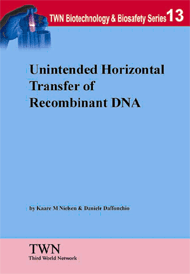|
|
|||
ABOUT THE BOOK Heritable material (DNA) is usually recombined and transferred to the progeny by sexual reproduction. This process is called vertical gene transfer and an example is pollen flow between the same or related plant species. DNA can, however, also more infrequently spread to unrelated species through a process called horizontal gene transfer (HGT). HGT occurs independently of normal sexual reproduction and is more common among single-celled organisms such as bacteria. Examples of HGT are the spread of antibiotic resistance among bacterial species, gene therapy in humans, and Agrobacterium-infection in plants. HGT of recombinant DNA from genetically modified organisms (GMOs) to bacteria is a potential biosafety concern. In this paper, the authors introduce the main biosafety aspects of unintended HGT processes as they relate to the use of recombinant DNA. ABOUT THE AUTHORS PROFESSOR
KAARE M NIELSEN is a Professor of Pharmaceutical Microbiology
at the Department of Pharmacy, the PROFESSOR
DANIELE DAFFONCHIO is an Associate Professor of Microbiology
at the Department of Food Science and Microbiology, studies
in Contents 1. INTRODUCTION 2. INTRODUCTION TO SOME BIOSAFETY ASPECTS OF RECOMBINANT DNA 3. RECOMBINANT DNA INTRODUCTION AND POTENTIAL IMPACT IN VARIOUS ENVIRONMENTS 3.1 Human exposure to foreign DNA 3.11 DNA in food 3.1.2 DNA stability in the digestive tract 4. HGT OF RECOMBINANT DNA TO EUKARYOTIC CELLS (E.G. HUMAN CELLS) 5. HGT OF RECOMBINANT DNA TO PROKARYOTIC CELLS (E.G. BACTERIAL CELLS) 6. CONCLUDING REMARKS ENDNOTES SUGGESTED REFERENCES PRICE POSTAGE Third World countries
Other foreign countries US$6.00 US$2.00 (air); US$1.00 (sea) (For orders of more than 3 copies, please write in for reduced postal rate) How to Order the Book Visit our TWN Online Bookshop or contact Third World Network at 131 Jalan Macalister, 10400 Penang, Malaysia. Tel: 604-2266159 Fax: 604-2264505 Email for further information. |
|||

